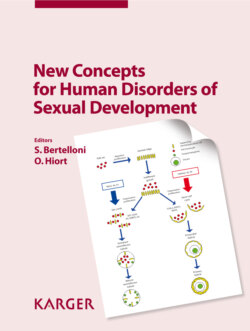Читать книгу New Concepts for Human Disorders of Sexual Development - Группа авторов - Страница 23
На сайте Литреса книга снята с продажи.
The Primitive Gonad
ОглавлениеBy day 32 post conception (pc), the gonadal anlagen can be recognised as paired bipotential structures in the developing human embryo. They are situated at the ventromedial surface of the mesonephros and appear from the mesoderm by contributions from somatic mesenchymal cells from the mesonephros and epithelial cells migrating from the coelomic surface of the gonadal ridge. As mentioned before, no sexual dimorphism can be distinguished morphologically at this stage of development. Primordial germ cells (PGCs), which become gonocytes later on, cannot be observed at this early time of gonadal formation [Shawlot and Behringer, 1995; Torres et al., 1995; Miyamoto et al., 1997; Birk et al., 2000; Failli et al., 2000; Park and Jamieson, 2005]. The temporal scale of the important early events of human gonadal differentiation is displayed in table 1.
The mesonephros also constitutes the primordium of the adrenal glands and the urinary system. Disruption by gene targeting of any of several involved transcription factors (online supplementary table 1; see www.karger.com/doi/10.1159/000317090) during genital ridge development results at all times in severely affected phenotypes with multiple malformations of the urogenital tract, adrenals and other structures. Therefore, a number of peptide growth factors have been compromised in gonadal development from the indifferent gonadal anlagen, most notably the insulin-like growth factor (IGF) superfamily [Nef et al., 2003]. The formation of the urogenital ridge is mainly controlled by 2 transcriptional regulators: the tumour suppressor gene Wilms’ tumour-associated gene-1 (WT1) and the orphan nuclear receptor steroidogenic factor-1 (SF1). WT1 is a DNA- and RNA-binding protein with transcriptional and posttranscriptional regulation capacity. It is expressed in gonadal stromal, coelomic epithelial cells and immature Sertoli cells, interacts with the cAMP-responsive element-binding protein CITED 2 and is regulated by ‘paired box gene 2’ (PAX2) (see online suppl. table 1). In rodents, disruption of Wt1 leads to lack of formation of kidneys, gonads and adrenals. Distinct but not identical phenotypes can be observed after WT1 loss-of-function (LOF) mutation in humans, resulting in pseudoher-maphroditism and/or urogenital and other malformations in boys with WAGR, Deny-Drash or Frasier syndromes [Pritchard-Jones et al., 1990; Park and Jamieson, 2005; online suppl. table 1]. SF1, expressed in gonadal ridges, is a transcriptional regulator of steroid hydrolases, gonadotropins and aromatase and involved in the stabilisation of intermediate mesoderm, follicle development and ovulation (online suppl. table 1). Additionally, SF1 regulates the anti-müllerian hormone (AMH), dosage-sensitive sex reversal-congenital adrenal hypoplasia critical region on the X-chromosome protein 1 (DAX1) and steroidogenic acute regulatory protein (StAR). These genes are expressed in the somatic testicular compartment and important for normal testicular cord formation, Leydig and Sertoli cell differentiation as well as the initial step of steroidogenesis (online suppl. table 1). Therefore, deletion of Sf1 in mice results in failure of gonadal and adrenal development, whereas the corresponding LOF mutation in humans has a less prominent gonadal phenotype and adrenal insufficiency [Biason-Lauber and Schoenle, 2000; Achermann et al., 2002; Park and Jamieson, 2005; online suppl. table 1]. For a comprehensive account of more genes involved in gonadal formation, please consult online suppl. table 1.
Table 2. Selection of protein expression patterns specific for different male germ cell types in the human testis
